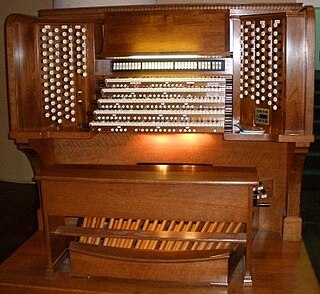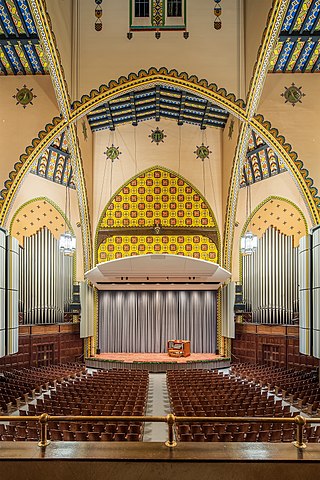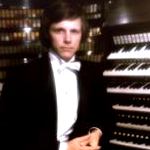Related Research Articles

The Sesqui-Centennial International Exposition of 1926 was a world's fair in Philadelphia, Pennsylvania. Its purpose was to celebrate the 150th anniversary of the signing of the United States Declaration of Independence, and the 50th anniversary of the 1876 Centennial Exposition.

In music, the organ is a keyboard instrument of one or more pipe divisions or other means for producing tones. The organs have usually two or three, up to five manuals, for playing with the hands, and pedalboard, with the feet. With the use of registers, several groups of pipes can be connected to one manual.

Rodgers Instruments Corporation is an American manufacturer of classical and church organs. Rodgers was incorporated May 1, 1958 in Beaverton, Oregon by founders, Rodgers W. Jenkins and Fred Tinker, employees of Tektronix, Inc., of Portland, Oregon, and members of a Tektronix team developing transistor-based oscillator circuits. Rodgers was the second manufacturer of solid state oscillator-based organs, completing their first instrument in 1958. Other Rodgers innovations in the electronic organ industry include solid-state organ amplifiers (1962), single-contact diode keying (1961), reed switch pedal keying for pedalboards (1961), programmable computer memory pistons (1966), and the first MIDI-supported church organs (1986).

Cyrus Hermann Kotzschmar Curtis was an American publisher of magazines and newspapers, including the Ladies' Home Journal and The Saturday Evening Post.

A pedalboard is a keyboard played with the feet that is usually used to produce the low-pitched bass line of a piece of music. A pedalboard has long, narrow lever-style keys laid out in the same semitone scalar pattern as a manual keyboard, with longer keys for C, D, E, F, G, A, and B, and shorter, raised keys for C♯, D♯, F♯, G♯ and A♯. Training in pedal technique is part of standard organ pedagogy in church music and art music.

A theatre organ is a type of pipe organ developed to accompany silent films, from the 1900s to the 1920s.

Casavant Frères is a Canadian organ building company in Saint-Hyacinthe, Quebec, which has been building pipe organs since 1879. As of 2014, the company has produced more than 3,900 organs.

The symphonic organ is a style of pipe organ that flourished during the first three decades of the 20th century in town halls and other secular public venues, particularly in the United States and the United Kingdom. It has roots in 19th-century Europe, and is a variation of the classical pipe organ. It features expanded capabilities, with many pipes imitative of orchestral instruments, and with multiple expressive divisions and organ console controls for seamlessly adjusting volume and tone, generally with electric organ actions and winding. These expansions let the organist approximate a conductor's power to shape the tonal textures of Romantic music and orchestral transcriptions. These organs are generally concert instruments as opposed to church organs. The symphonic organ has seen a revival in the US, Europe and Japan, particularly since the 1980s.

The Wanamaker Grand Court Organ, located in Philadelphia, Pennsylvania is the largest fully-functioning pipe organ in the world, based on the number of playing pipes, the number of ranks and its weight. The Wanamaker Organ is located within a spacious 7-story Grand Court at Macy's Center City and is played twice a day Monday through Saturday. The organ is featured at several special concerts held throughout the year, including events featuring the Friends of the Wanamaker Organ Festival Chorus and Brass Ensemble.

Austin Organs, Inc., is a manufacturer of pipe organs based in Hartford, Connecticut. The company is one of the oldest continuously-operating organ manufacturers in the United States. The first instruments were built in 1893 with the Austin Patent Airchest, and many remain in fine playing condition to this day.

The Boardwalk Hall Auditorium Organ is the pipe organ in the Main Auditorium of the Boardwalk Hall in Atlantic City, New Jersey, built by the Midmer-Losh Organ Company. It is the largest organ in the world, as measured by the number of pipes.

Irvine Auditorium is a performance venue at 3401 Spruce Street on the campus of the University of Pennsylvania, in Philadelphia. It was designed by the firm of prominent Philadelphia area architect Horace Trumbauer and built 1926–1932. Irvine Auditorium is notable for its nearly 11,000-pipe Curtis Organ, the world's 22nd-largest pipe organ, originally built for the Sesquicentennial Exposition of 1926 and donated to the university in 1928. The building was opened in May, 1929.

Gordon Turk is an American concert organist. He has played throughout the United States, made two concert tours in Japan, and performed frequently in Europe, including Ukraine and Russia, both as solo organist and with orchestra.

Richard (Irven) Purvis was an American organist, composer, conductor and teacher. He is especially remembered for his expressive recordings of the organ classics and his own lighter compositions for the instrument.

The Kotzschmar Memorial Organ, usually referred to as the Kotzschmar Organ, is a pipe organ located at Merrill Auditorium in the City Hall of Portland, Maine, United States.

Keith Chapman (1945–1989) was an American concert organist known best for his flair at playing in the symphonic style of organ performance, and particularly for his long and distinguished association (1966–1989) with the Wanamaker's Department Store of Philadelphia as the principal organist of the Wanamaker Organ.
Johann Carl Hermann Kotzschmar was a German-American musician, conductor, and composer.
Ted Alan Worth was an American church and concert organist, recording artist, and entrepreneur of the pipe organ.

Louisville Memorial Auditorium, located at 970 South Fourth Street, is a concert venue of Greek Revival design. It was dedicated on Memorial Day, May 30, 1929, as a memorial to the people of Louisville who served in World War I. In 1954, the ceiling was lowered and the side balconies were closed off reducing the seating capacity from 2,349 to 1,742 to improve the acoustics.
References
- ↑ "Archived copy". Archived from the original on 2007-07-24. Retrieved 2007-07-09.
{{cite web}}: CS1 maint: archived copy as title (link) Austin Organ Company webpage including the Curtis Organ - ↑ "The Sesquicentennial Exposition of 1926". Archived from the original on 2010-07-13. Retrieved 2010-10-12. "...the entire festival was placed into equity receivership by the United States District Court on April 27, 1927." Philadelphia City Archives, Record Group 232, Sesquicentennial Exhibition Association.
- ↑ Keith Chapman (organist)